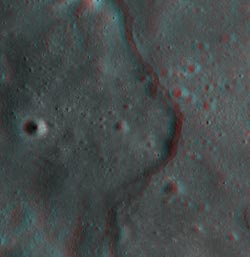Lunar Reconnaissance Orbiter Explores the Moon in 3-D

Lobate scarps (a type of cliff) on the moon are found mostly in the highlands, and are relatively small and young. Scientists propose that they form as result of fracturing of the crust as the moon shrinks. Why is the moon shrinking? As the core slowly cools portions freeze from a liquid to a solid thus taking up less volume. Since the lobate scarps are small, hundreds of meters to several kilometers in length, and 10 to 50 meters in height, they must be young; otherwise everyday small meteor bombardment would have obliterated them. (Credit: NASA/Goddard/Arizona State University)<br>
The Lunar Reconnaissance Orbiter Camera Narrow Angle Camera (LROC NAC) team from the University of Arizona and Arizona State University are currently developing a processing system to automatically generate anaglyphs from most of these stereo pairs.
An anaglyph is an image that can be viewed in 3-D using red-blue/green glasses.
LROC acquires stereo images by targeting a location on the ground and taking an image from one angle on one orbit, and from a different angle on a subsequent orbit.
Anaglyphs are used to better understand the 3-D structure of the lunar surface. The LROC NAC anaglyphs make lunar features such as craters, volcanic flows, lava tubes and tectonic features jump out in 3-D. LROC NAC anaglyphs will make detailed images of the moon's surface accessible in 3-D to the general public.
The anaglyphs will be released through the LROC web site at http://lroc.sese.asu.edu/ and the NASA LRO web site at www.nasa.gov/lro as they become available.
Media Contact
All latest news from the category: Physics and Astronomy
This area deals with the fundamental laws and building blocks of nature and how they interact, the properties and the behavior of matter, and research into space and time and their structures.
innovations-report provides in-depth reports and articles on subjects such as astrophysics, laser technologies, nuclear, quantum, particle and solid-state physics, nanotechnologies, planetary research and findings (Mars, Venus) and developments related to the Hubble Telescope.
Newest articles

Recovering phosphorus from sewage sludge ash
Chemical and heat treatment of sewage sludge can recover phosphorus in a process that could help address the problem of diminishing supplies of phosphorus ores. Valuable supplies of phosphorus could…

Efficient, sustainable and cost-effective hybrid energy storage system for modern power grids
EU project HyFlow: Over three years of research, the consortium of the EU project HyFlow has successfully developed a highly efficient, sustainable, and cost-effective hybrid energy storage system (HESS) that…

After 25 years, researchers uncover genetic cause of rare neurological disease
Some families call it a trial of faith. Others just call it a curse. The progressive neurological disease known as spinocerebellar ataxia 4 (SCA4) is a rare condition, but its…





















